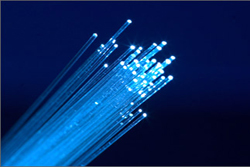Europe's online source of news, data & analysis for professionals involved in packaged media and new delivery technologies

World record fiber optics transmission - 10.2 Terabit/s or 240 DVDs per second
Researchers at Berlin’s Fraunhofer Heinrich Hertz Institute send data at a speed of 10.2 Terabit per second over fiber optics, the equivalent of 240 DVDs per second – a world record in serial data transmission via fiber optics.
In a new world premier, members of Berlin’s Fraunhofer Heinrich Hertz Institute in collaboration with the Technical University of Denmark in Copenhagen have succeeded in generating a serial data rate of 10.2 Terabit per second and transmitting it over a 29 km long fiber optic link.
This breakthrough was achieved by an even more rapid and comprehensive modulation of the light signal transported in the fiber optic cable on a single optical carrier or wavelength. This new record puts the previous world record held by the Heinrich Hertz Institute of 2.65 Terabit per second in the shade.
Fraunhofer HHI’s new record is based on two innovations. On the one hand, the data transmission pulse repetition rate is increased by switching on and off the flashes transmitting the data in the fiber optic cable much more rapidly and with shorter breaks than ever before. In other words, every 800 femoseconds researchers sent an optical pulse of just 300 femoseconds pulse duration down the optical cable, giving a pulse repetition rate of 1.28 THz – with 32 times more repetition than in commercial 40 Gbit/s transmission systems. (A femosecond is one millionth of a nanosecond, itself one billionth of a second).
On the other hand, researchers increased the amount of information transmitted in each flash by modulating not just the amplitude but the optical phase of the electromagnetic light wave as well.
Scientists at Fraunhofer HHI made the first public presentation of their work last week at the Optical Fiber Communications Conference (OFC 2011) in Los Angeles.
Story filed 17.03.11




















